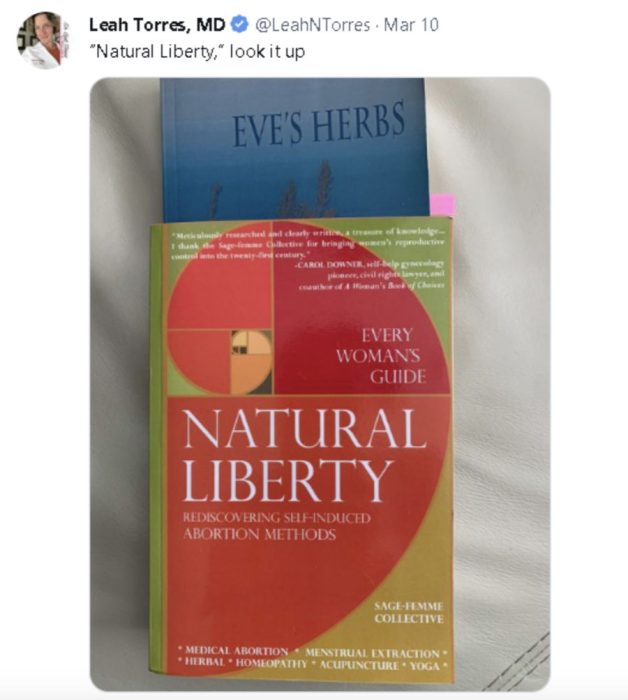On Twitter last month, abortionist Leah Torres recommended a 2008 book that instructs women how to induce abortions on themselves using plants and herbs.
Extremely dangerous methods of ‘dubious’ effectiveness
Even though the authors of the 2008 book admit that their methods have “dubious” effectiveness and are “inherently dangerous,” they give detailed instructions on how to find, prepare, and use plants to (they claim) cause abortions.
The book describes a plant, instructs how to harvest/acquire it, discusses its alleged historical use, makes unsubstantiated claims about its effectiveness, then gives possible side effects and dangers. Following this, the book gives detailed instructions on how to prepare parts of these plants to self-induce an abortion.
The book cites very few studies on these plants and any examples it gives of their successful use in aborting a baby date back to the 1800s or earlier.

Screenshot
Potentially life-threatening, toxic effects
The book warns of the following “signs of toxicity” for various herbs that it recommends, including:
- “Severe intestinal pain and red-colored urine.”
- “Stomach pain, nausea, diarrhea, dilated pupils, labored breathing, weak and rapid pulse, and frothing at the mouth and convulsions.”
- “Heart stimulation… distortion of the stomach, spasms, convulsions, and unconsciousness.”
- “Gastrointestinal irritation, vomiting, diarrhea, respiratory distress, congestion, fluid accumulation around the tissues of the heart and even death.”
- “Dizziness, vomiting, dry mouth, thirst, and nosebleeds.”
- “Nausea, diarrhea, abdominal or joint pain, tremors, headache, visual dimness, depressed heart rate… convulsions.”
- “Gastrointestinal inflammation, dizziness,… painful spasms, catharsis, thirst with abdominal heat, dilation of the pupils, cold sweats, convulsions, heart failure.”
- “Nausea, vomiting, gastritis, headache, sore throat, thirst, elevated blood pressure, dilated pupils, muscle weakness, loss of coordination, cardiovascular collapse, and convulsions.”
- “Violent vomiting and diarrhea, dehydration, gastrointestinal bleeding, skin cold and clammy, reduced pulse, and collapse.”
- “Nausea, vomiting, vertigo, convulsions, personality changes, delirium, and hallucinations.”
- “Itching, rash, gastrointestinal disturbances, racing heartbeat, and transitory headaches.”
- “Loss of body weight, choking sensation, vomiting, hypercatharsis, and kidney irritation.”
- “Profuse sweating, irritation of the stomach and intestines, loss of strength, and disorientation.”
- “Diarrhea, purplish urine, blood in the urine, kidney pain, intestinal pain, elevated blood pressure, and a quickened heartbeat.”
- “Malaise, unpleasant sensations in the head, dimness of vision, cerebral heaviness, dizziness, mental excitation, laryngeal and pharyngeal constriction.”
- “Headache, hallucinations, nausea, acute cramping, gastroenteritis, vomiting, diarrhea, weak pulse, decreased heart rate, muscle spasms and convulsions.”
- “Delirium, hallucinations, excitement, thought disorder, a sense of impending death and agitation.”
- “Decreased heart rate, heart palpitations, visual changes, and difficulty breathing when lying down.”
- “Nausea, hallucinations, vomiting, vertigo, hives, paralysis, liver swollen and painful, urine scanty and darkly colored, and tremors.”
- “Nausea, numbness in hands and legs, liver irritation, kidney and bladder irritation, and diarrhea.”
- “Muscle weakness, dizziness, nausea, vomiting, prolonged and abnormal dilation of the eye, dimness of vision, and loss of vision.”
- “Changes in personality, stupor, gastrointestinal irritation, nausea, and vomiting.”
- “Confusion, exhaustion, severe stomach pain, vomiting, convulsions, and fatality.”
- “Flush of redness to the skin; nosebleed; heaviness in the head; changes in personality; stupor; excessive gaiety; convulsive laughter; sleepiness; vertigo; vomiting; loss of muscular control; and loss of consciousness.”
- “Violent gastroenteritis, circulation system and nervous system depression, cardiac failure, and renal failure.”
- “Nausea, vomiting, inflammation of the stomach lining, dilated pupils, weakened and/or rapid pulse, convulsions, and coma.”
- “Vomiting, pains in the abdomen, and convulsions.”
Discouraging women from seeking medical help
What does the book say to do if a woman experiences these symptoms? It instructs, “As a rule, always reduce dosage at the first sign of toxicity.” It repeats this advice three times.
Someone experiencing such severe symptoms should immediately stop taking the herb and go directly to a hospital. Instead, the book tells women to continue poisoning themselves, putting the women at serious risk.
Telling women to lie to doctors
If the woman does go to the emergency room after taking any of these poisonous herbs, the book instructs her to lie to doctors and say that she’s having a miscarriage.
The book claims, “[T]he treatment and care is the same whether a woman has complications arising from an induced abortion or spontaneous miscarriage.”
This is obviously untrue. If a woman has poisoned herself with a deadly substance, she needs to be treated for that poison. A naturally occurring miscarriage only requires treatment for the miscarriage. Ingesting toxic herbs leads to a whole other set of medical problems that need specific medical care.
The book warns, “If a woman chooses to tell medical personnel about how she attempted or succeeded at a self-induced abortion, she may be arrested,” and advises her to “exercise the Fifth Amendment to refuse to answer questions which may incriminate.”
This book was written when abortion was legal in every state and Roe v. Wade was still in effect. Even today, there isn’t a law in the country that says women who have an abortion will be charged with a crime.
Encouraging women not to tell doctors that they’ve ingested something toxic is incredibly irresponsible and could easily lead to fatalities.
The risk of death from fatal poisoning
Warnings in the book include:
- “Many members of the… family are highly poisonous and all can be easily mistaken for each other.”
- “Acute renal failure has been reported from dosages as low as 60 g. Use extreme caution.”
- “Sixteen drops of the oil has caused unconsciousness, spasms, and convulsions.”
- “At high doses, death typically occurs from cardiovascular collapse within 10 hours of ingestion.”
And many more.
One plant the book suggests to women contains the poison ricin, which is 6,000 times deadlier than cyanide and 12,000 times deadlier than rattlesnake venom.
Of six different herbs, it says, “[T]he reader must keep in mind that deaths have resulted from ingestion.” Nine herbs have caused “many deaths;” one has caused “some” deaths, and two have caused “occasional” deaths.
Harm to the babies who survive
The book also warns women that if the herbs fail to induce abortions, they could all cause fetal deformities. So if the baby lives, she may suffer lifelong health problems as a result of her mother ingesting the herbs. This warning also discourages women from changing their minds after trying these self-induced abortion methods.
By recommending the book, Torres is risking women’s lives and putting them in grave danger.
Source: Sage-Femme Collective Natural Liberty: Rediscovering Self-Induced Abortion Methods (Las Vegas, Nevada: Sage-femme, 2008)








